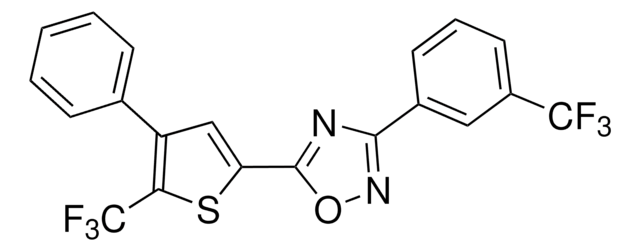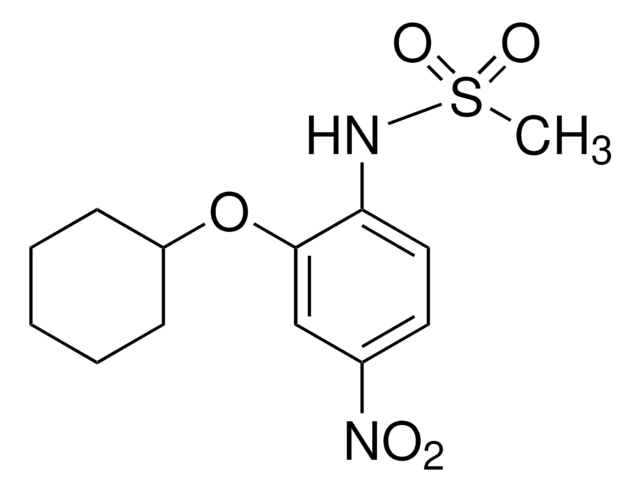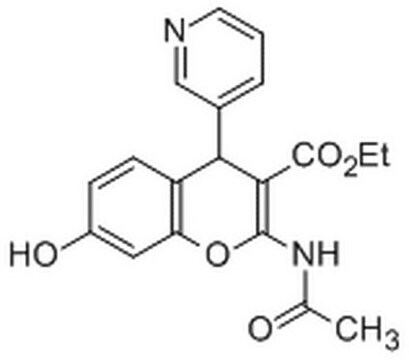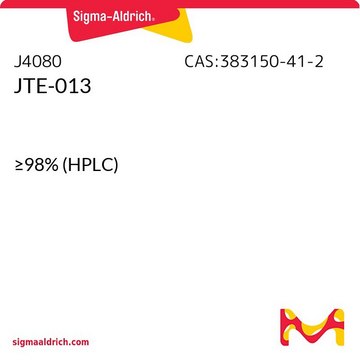SML2499
TY-52156
≥98% (HPLC)
别名:
1-(4-Chlorophenylamino)-1-(4-chlorophenylhydrazono)-3,3-dimethyl-2-butanone, 1-(4-Chlorophenylhydrazono)-1-(4-chlorophenylamino)-3,3-dimethyl-2-butanone, N-(4-Chloroanilino)-N′-(4-chlorophenyl)-3,3-dimethyl-2-oxobutanimidamide, TY 52156, TY52156
登录查看公司和协议定价
所有图片(1)
About This Item
推荐产品
化驗
≥98% (HPLC)
形狀
powder
顏色
white to very dark brown
溶解度
DMSO: 2 mg/mL, clear
儲存溫度
2-8°C
SMILES 字串
CC(C)(C(/C(NC1=CC=C(C=C1)Cl)=N/NC2=CC=C(C=C2)Cl)=O)C
InChI
1S/C18H19Cl2N3O/c1-18(2,3)16(24)17(21-14-8-4-12(19)5-9-14)23-22-15-10-6-13(20)7-11-15/h4-11,22H,1-3H3,(H,21,23)
InChI 密鑰
XONRRGIRSGNWFP-UHFFFAOYSA-N
生化/生理作用
Orally active, potent and selective sphingosine 1-phosphate (S1P) receptor 3 (S1P3; S1PR3) antagonist with in vitro and in vivo efficacy.
TY-52156 is a potent sphingosine 1-phosphate (S1P) receptor 3 (S1P3; S1PR3) antagonist that selectively inhibits S1P-stimulated Ca2+ response in human S1P3-expressing cells (Ki = 110 nM) and Eu-GTP binding to S1P3-containing membranes over those of S1P1/2/4/5. TY-52156 inhibits S1P3-dependent signaling events in human coronary artery smooth muscle cells (1 μM), S1P3-dependent coronary flow decrease in perfused rat hearts, as well as S1P3-mediated acute mechanical pain in mice (10 nmol/20 μL/paw id.) and bradycardia in anesthetized rats (30 mg/kg TY-52156 p.o.) in vivo with good oral bioavailability (F = 70.9%; 1 mg/kg p.o. in rats).
儲存類別代碼
11 - Combustible Solids
水污染物質分類(WGK)
WGK 3
閃點(°F)
Not applicable
閃點(°C)
Not applicable
Zhijing Zhao et al.
Experimental and therapeutic medicine, 15(6), 5007-5016 (2018-05-29)
Thyroid carcinoma is characterized by an aggressive behavior, lack of effective targeted therapies and a high rate of relapse. Sphingosine kinase 1 (SPHK1) has been reported to be a critical regulatory factor in the progression of thyroid carcinoma, but the
Xiao-Jing Sun et al.
Journal of cellular and molecular medicine, 22(3), 1769-1777 (2017-11-24)
Cumulating evidences suggested an important role of sphingosine-1-phosphate (S1P) and its receptors in regulating endothelial barrier integrity. Our previous study revealed that the circulating S1P levels and renal expression of S1PRs correlated with disease activity and renal damage in patients
Iuliia Filipenko et al.
Biochimica et biophysica acta, 1861(11), 1840-1851 (2016-09-13)
Breast cancer is one of the most common and devastating malignancies among women worldwide. Recent evidence suggests that malignant progression is also driven by processes involving the sphingolipid molecule sphingosine 1-phosphate (S1P) and its binding to cognate receptor subtypes on
Akira Murakami et al.
Molecular pharmacology, 77(4), 704-713 (2010-01-26)
Sphingosine 1-phosphate (S1P) induces diverse biological responses in various tissues by activating specific G protein-coupled receptors (S1P(1)-S1P(5) receptors). The biological signaling regulated by S1P(3) receptor has not been fully elucidated because of the lack of an S1P(3) receptor-specific antagonist or
Luca Piali et al.
Pharmacology research & perspectives, 5(6) (2017-12-12)
Sphingosine-1-phosphate receptor 1 (S1P1 ) modulators sequester circulating lymphocytes within lymph nodes, thereby preventing potentially pathogenic autoimmune cells from exiting into the blood stream and reaching inflamed tissues. S1P1 receptor modulation may thus offer potential to treat various autoimmune diseases.
我们的科学家团队拥有各种研究领域经验,包括生命科学、材料科学、化学合成、色谱、分析及许多其他领域.
联系技术服务部门








